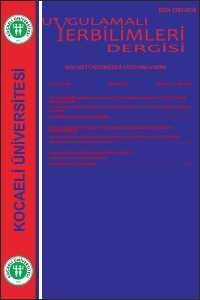Marmara Bölgesi Orta-Küçük Depremlerinin Mw-ML Dönüşüm Bağıntısı
Lokal magnitüd, Marmara Bölgesi, Moment magnitüdü, P-dalgası spektrum
The Relationship of MW-ML Conversion for the Earthquakes of the Marmara Region
Local magnitude, Marmara Region, Moment magnitude, P-wave spectra,
___
- AKI K., 1966. Generation and propagation af G waves from the Niigata earthquake of June 16, 1964: Part 2, Bull. Earthq. Res. Inst. Tokyo Univ., 44, 73-88.
- AKI K., 1967. Scaling law of seismic spectrum, Journal of Geophysical Research, 72.4, 1217-1231.
- BRUNE J. N., 1970. Tectonic stress and the spectra of seismic shear waves from earthquakes, Journal of Geophysical Research, 75.26, 4997-5009.
- BRUNE J. N., 1971. Correction (to Brune, 1970), Journal of Geophysical Research, 76, 5002.
- GUPTA H. K., RAO N. P., RASTOGI B. K., SARKAR D., 2001. The deadliest intraplate earthquake, Science, 291, 2101-2102.
- HANKS T. C., KANAMORI H., 1979. A moment magnitude scale, Journal of Geophysical Research: Solid Earth, 84.B5, 2348-2350.
- HASKELL N. A., 1964. Total energy and energy spectral density of elastic wave radiation from propagating faults. Bulletin of the Seismological Society of America, 54.6A, 1811-184.
- IRMAK T. S., 2000. The source-rupture processes of recent large Turkey earthquakes, Individual studies by participants to the International Institute of Seismology and Earthquake Engineering, 36, 131-143.
- IRMAK T. S., ÖZER M. F., KENAR Ö., 2001. 12 Kasım 1999 Düzce depremi kaynak ve yırtılma mekanizması, Aktif Tektonik Araştırma Grubu 4. Toplantısı Makaleler Kitabı, 39-48.
- IRMAK T. S., GUVEN T., TUNÇ B., ULUTAŞ E., ÇETİNOL T., ÇAKA D., ALPARSLAN N., ÖZER M. F., BARIŞ Ş., AŞÇI M., TUNÇ S., 2005. Kocaeli ve çevresinin deprem aktivitesi, Kocaeli Mimarlar Odası Özel Sayısı, 100-103.
- KALAFAT D., 2011. Marmara Bölgesi'nin Depremselliği ve Deprem Ağının Önemi, 1. Türkiye Deprem Mühendisliği ve Sismoloji Konferansı, Ankara, Türkiye.
- KANAMORI H., 1983. Magnitude scale and quantification of earthquakes, Tectonophysics 93, 185–199.
- KASAHARA K., 1957. 2. The Nature of Seismic Origins as Inferred from Seismological and Geodetic Observations (2).
- KEILIS-BOROK V. I., 1960. Investigation of the mechanism of earthquakes, Sots, Res. Geophys. (English transl.) 4, 29.
- KINSCHER J., KRUGER F., WOITH H., LÜHR B. G., HINTESBERGER E., IRMAK T. S., BARIS S., 2013. Seismotectonics of the Armutlu peninsula (Marmara Sea, NW Turkey) from geological field observation and regional moment tensor inversion, Tectonophysics, 608, 980-995.
- KOÇYİĞİT A., 2006. Marmara Bölgesinin Depremselliği ve Deprem Kaynakları (Faylar), Türkiye Jeoloji Kurultayı, 20-24.03.
- LOMNITZ C., ELIARRARAS S. R., 2001. El Salvador 2001: earthquake disaster and disaster prevention preparedness in a tropical volcanic environment, Seism. Res. Lett., 72, 346-351.
- MATLAB Release 2011a, The Mathworks, Inc, Natick, Massachusetts, United States.
- SÜLE B., WEBER Z., 2013. Earthquake source parameters and scaling relationships in Hungary (central Pannonian basin), Journal of Seismology, 17.2, 507-521.
- TUNÇ B., IRMAK T. S., WOITH H., TUNC S., BARIS Ş., OZER M. F., LÜHR B. G., GUNTHER E., GROSSER H., ZSCHAU J., 2011. The Armutlu Network: an investigation into the seismotectonic setting of Armutlu–Yalova–Gemlik and the surrounding regions, Annals of Geophysics, 54.1, 35-45.
- YAVUZ E., ALTUN G., HORASAN G., 2013. Sakarya Üniversitesi Deprem Kayıt İstasyonuna ait Süreye Bağlı Büyüklük Hesabı, 2. Türkiye Deprem Mühendisliği ve Sismoloji Konferansı, Hatay, Türkiye.
- YAVUZ E., ÇAKA D., TUNÇ B., IRMAK T. S., WOITH H., CESCA S., LÜHR B. G., BARIŞ Ş., 2015. Earthquake Swarm in Armutlu Peninsula, Eastern Marmara Region, Turkey, European Geosciences Union General Assembly 2015, 5099, Vienna, Austria.
- ISSN: 1302-0218
- Başlangıç: 1996
- Yayıncı: Kocaeli Üniversitesi
Jeofizik Yöntemlerle Heyelan Araştırmaları
Zemin Hakim Periyodu ve Bina Yüksekliği Rezonans İlişkisi
Marmara Bölgesi Orta-Küçük Depremlerinin Mw-ML Dönüşüm Bağıntısı
Yunus Emre Şahin, Tahir Serkan Irmak, Hamdullah LİVAOĞLU, Evrim YAVUZ
Sanayileşen Alanlarda Tarım Topraklarını Koruma Güçlüğü: Trakya Bölge Planlama Deneyimi
Deniz Sismiğinde Hayalet Yansımaların Giderilmesinin Sismik İmaja Etkisi
